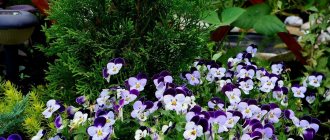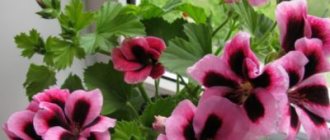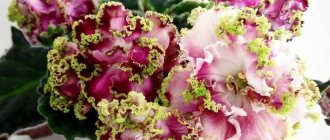Description of violet Chic poppy
The leaves form a rosette, the color from the center of the plate to the periphery turns from green to white, there are also pure white ones.
Flowers on tall peduncles reach 8 cm in diameter. In the first years, they bend under the weight of the buds and fall, then the plant grows stronger and this does not happen. Flowering is long lasting. The petals unfurl slowly. Fringed at the edges. The pink young buds then take on rich brick hues. It can be propagated by leaf cuttings, which root well and produce up to 3 rosettes, but this requires a lot of light.
Features of flowering, growth and reproduction
When flowering, the violet SM-Chic Poppy changes the shade of the petals, pink tones give way to shades of brick-terracort, this red color is especially noticeable in an adult plant.
Violet growers also note a slight weakness of peduncles in fragile rosettes. During the first and second flowering, under the weight of huge flowers, they fall onto the leaves, and already on the third flowering, large bouquets of flowers stand evenly in a dense cap.
How long does it take to grow an adult plant?
The violet grows slowly, the growth process is delayed especially during the growth period from baby to starter.
For rooting cuttings , you cannot take completely white leaves; they have practically no ability to produce chlorophyll, so you may not expect healthy offspring.
Attention! In general, with good lighting, cuttings produce a lot of children, and when placed in a greenhouse, they quickly gain green mass.
Reproduction methods and features
The variety is propagated by stepsons and cuttings. Despite the fact that SM-Chic Poppy never received the official status of a variety, but remained a seedling, it is very resistant to propagation - it very rarely goes into sport.
Flowering in hot and cool conditions
In excessive light:
- The flower fades quickly;
- The leaves begin to curl;
- And if there is a deficiency, the petioles of the foliage lengthen, spoiling the decorative appearance of the rosette.
It is necessary to monitor the violet in the heat.
What do flower stalks look like?
Delicate and large flowers are located on high peduncles . Each peduncle usually produces two or three buds; due to their heaviness, the huge flowers bend the peduncles at the young rosette.
Important! As the rosette matures, during the second or third flowering, with proper care, the peduncles become stronger, and the factor of drooping flowers is practically smoothed out.
Is it possible to achieve cap flowering?
The Moreva Chic Poppy seedling blooms quite often, and the flowering period is quite long . Large flowers, reaching centimeters in diameter, create the illusion of a dense cap, even if there are only three flowers on the rosette.
Bud lifespan
Double flowers open slowly, gradually increasing in size . In cool conditions, fire brick flowers fade less, maintaining freshness longer.
Planting and growing conditions for violets Chic poppy
A chic poppy requires special treatment and increased attention to itself; it is difficult to create suitable conditions, but its appearance is delightful and worth all the effort.
| Parameter | Conditions |
| Location | A lot of light is needed, but keep out of direct sunlight to avoid burns. West or east side is the best location. From the south, the flower will have to be covered in the summer. |
| Lighting | Necessary for flowering and preserving the beauty of rosettes. When there is insufficient lighting, the cuttings stretch. If there is excess, the lower leaves become curled, which also leads to loss of decorativeness. There is at least 12 hours of daylight, so additional lighting is indicated in winter. |
| Temperature | Optimal - +19…+23 °С. Avoid sudden fluctuations. |
| Humidity | Not lower than 50%. During the cold period, additional air humidification is necessary. You can place water in an open container near the flower. |
| Priming | A specially prepared substrate is available for sale, but various mixtures can also be prepared:
Use slightly acidic soil (up to 6.5) or neutral 7.0. The soil is replaced approximately once a year. To protect against fungal diseases, mix activated carbon or sphagnum moss into the soil. To destroy fungal spores and other pests, before planting, the soil is heated in the microwave, in the oven, or poured with boiling water. |
| Pot | 3 times smaller than an outlet. You don't need a lot of land. A plastic one will do, but if there are holes in the bottom of the pot for drainage, which is necessary to prevent stagnation of water and the development of rot on the roots. It can be expanded clay, pebbles, small crushed stone, broken brick. Frequent replanting into a more suitable pot is required. |
Reviews
Olga. “Oh, I fell in love with this variety. The flowers are huge and fluffy. It always blooms for three months, well, for a very long time, almost without a break.”
Natalia. “I fell in love with this Morev seedling at first sight; I have never seen such a gorgeous variegated rosette. I planted a leaf six months ago, now there are four trees from it, it takes a long time to gather leaves, but such beauty is worth it!”
Every gardener dreams of the Chic Poppy variety.
Mr. Summer Resident warns: proper watering for violets Gorgeous poppy
This plant does not tolerate overwatering or drying out of the substrate.
If you overwater it in hot weather, it can die from a bacterial infection that quickly spreads through the leaves.
The tender parts of the flower are also affected when water gets on them. Therefore, the following watering measures must be observed:
- the water must be settled or filtered;
- hard soften with oxalic acid 0.5 tsp. for 6 l.;
- be sure to fill the drainage before planting;
- do not allow liquid to stagnate in the container under the pot;
- violet cannot be sprayed.
Watering methods:
- From a watering can on top, but avoid getting any drops on the plant.
- Bottom watering: the pot is placed in a pan of water for half an hour, after which it is removed.
- Through the wick. During planting, stretch part of the cord through the drainage and the ground and plant the flower. Then place the pot over a container of water so that the wick is in the liquid and the bottom is not in contact with it. As a result, soil moisture will be maintained at an optimal level.
Color
Violets come in different colors; in addition, several shades can appear in one flower in the form of stripes, spots or borders. For example, the flowers of the varieties “Duchess” and “Isadora” are white and purple. And “Chic Poppy” is generally difficult to classify within one tone. Its flowers are usually described as orange-pink.
Violet "Duchess"
Bright red “Chic Poppy”
White violets. This includes the following varieties: “Alpha Centauri”, “Zephyr”, “Alpine”, etc.
Wonderful soft pink variety “Zephyr”
Beautiful white violet with blue edges of petals
Blue Saintpaulias: “Sea Myth”, “Curls of Venus”, “Blue Dragon”.
Blue violets symbolize harmony and tranquility
Thanks to its small dimensions, violets can easily decorate the smallest windowsill without taking up much space.
Red Saintpaulias include the chimera violet "Magenta" with semi-double flowers decorated with white stripes. Many of the varieties with red flowers have the word “rose” in their name. For example, violet “Rose of the Arctic”.
Red violet "Magenta"
Red violets look very impressive
There are a lot of Saintpaulias of luxurious purple color: “Esmeralda”, “Old Pond”, “Fountains of Peterhof”.
"Fountains of Peterhof"
Thanks to their beauty, violets grow in almost every home
Feeding violets Chic poppy
It is carried out with ready-made liquid fertilizers. During the flowering period it is necessary to apply every week. If appropriate conditions are not provided in winter: temperature and light conditions, once every 30 days is sufficient.
Young violets require nitrogen compounds during the growing season, while mature ones preparing for flowering require phosphorus and potassium compounds.
If the violet has been properly cared for, watered and fed in a timely manner, but the plant is still depleted, you need to check the acidity of the soil. If you deviate from a slightly acidic reaction in one direction or the other, Saintpaulia’s ability to fully absorb nutrients from the soil is lost.
Properties
Name
- Original: Chic Poppy
- Transcription:
- Translation:
Registration
- Selection: K.Morev
- Year:
Socket
- Socket type: standard
Flower
- Flower size, up to: 7 cm
- Flower shape: star
- Terry: terry, semi-double
- Main color: orange pink
- Color type: plain
- Border: none
- Other features:
Foliage
- foliage color: light green
- foliage shape: pointed, slightly quilted.
- reverse side of sheet: pink
- leaf edge: jagged, slightly wavy
- variegation: bordering (Tommy Lowe).
Transplanting violets Gorgeous poppy
Done in early spring and October. Flowering plants should not be replanted. In case of excessive watering and slow growth, an unscheduled procedure is performed. You don’t need a lot of soil; the pot is 1/3 the size of the rosette. 24 hours before transplanting, water the violet. Then the healthy plant is transferred with a lump of earth into the prepared pot, into moist soil. If there are rotten roots, old, diseased leaves, then they are removed. After transplantation, do not water for 48-72 hours. It is allowed to place the flower under a jar to maintain high humidity.
How to propagate
Propagation of the “Chic Poppy” violet is recommended by leaf cuttings and children. This Saintpaulia produces many daughter rosettes, and its leaves take root easily. Reproduction using rosettes is usually carried out during the period of flower transplantation. When the violet grows and the pot becomes crowded, it needs to be replanted and the rosettes separated.
In this case, it is necessary to carefully remove the flower from the pot and separate the stepsons along with part of the root system. They are then planted in separate pots. A good and healthy plant tolerates transplantation normally.
Another, easiest way, is propagation using leaves. To do this, absolutely healthy leaves are carefully separated from the bottom of the violet. The length of the petiole must be at least 1.5 cm. The leaf is placed in settled water.
As soon as the petiole takes root, it can be planted in a small pot with prepared soil for violets and drainage. Then the top of the container is covered with a plastic bag and transferred to a warm room with good lighting.
Every day, remove the bag for ventilation for 10–15 minutes and moisten the soil as needed. A leaf can sit in the ground for a long time and not develop, and sometimes even wither away. Here you need to be patient and wait. After the first leaves appear, the main leaf is cut off, but only if it has not withered. A healthy leaf can be used again for propagation. During the rooting period, planting material should be provided with optimal lighting.
We recommend reading how to prepare soil for violets and what the composition should be.
Classification
All varieties of double violets can be divided into groups according to several criteria. For example, depending on the degree of terryness, two main groups are distinguished:
- Terry;
- Semi-double.
In the photo you can see a terry violet. Also, there is a division into groups, depending on the appearance of the Saintpaulia inflorescence:
- Pectinate;
- Carnation.
According to color scheme they are distinguished:
- Light terry violets;
- Dark terry varieties.
IMPORTANT! Violets of several colors conditionally form separate groups of double Gesnerievs. The first includes Saintpaulias of red, pink and raspberry varieties
The second is formed by plants with blue, blue and lilac flowering.
Among the light representatives of terry, in particular, the following varieties are distinguished:
- Atlantis;
- Bridal bouquet;
- Lyubasha;
- And also several others.
Dark Saintpaulias are adequately represented by the varieties Chateau Brion and Gift for a Beloved.
Most often, on the windowsills of avid flower growers, you can see Saintpaulias with a simple type of terry. These plants differ from all other types:
- Leaf shape (round soft leaves of dark green color);
- And also the structure of the flower of the plant.
In representatives of the genus with a simple type of terry, the corolla consists of 4-6 petals.
Flowers with the so-called comb degree of doubleness usually have at least 6 petals in the corolla of the flower. More often, the number of petals of such a plant can be at least 8-9 pieces.
One of the most famous scallops is the Gift for a Beloved variety. It is also distinguished from other terry varieties by the shape of its petals. The fact is that in plants with this type of terry, the top of the flower has a wavy shape with a fringe on top of the flower.
Semi-double flowers are recognizable:
- By the shape and color of the leaves (round or oval, velvety, light green);
- And also by the number of petals in a flowering rosette (from 6 to 9).
In turn, terry Saintpaulias have 10 or more petals in a flower rosette.
As for the degree of terryness like carnations, such varieties have an incompletely opened rosette with semi-double petals.
ATTENTION! The shape of the flowers of such violets resembles carnation flowers, hence their name.
Care
In order to preserve the multi-colored color of Saintpaulias, for which they are so valued by collectors and simply amateur flower growers, it is necessary to follow some rules.
- Special soil containing less nitrogen than for ordinary violets.
- Additional light source. It is desirable that it be diffused light. Areas of the petals that do not contain green pigment react negatively to direct exposure to sunlight. Leaf scorching may even occur.
- Moderate temperature. Most variegated violets do not tolerate heat well, and at temperatures above 28 degrees they lose their individual color.
Due to the fact that in white leaves the process of chlorophyll formation proceeds more slowly than in ordinary varieties, they are less viable. Therefore, it is believed that the best leaves for propagation are completely green.
Birch - a houseplant similar to a birch tree
In many offices, schools and simply huge public spaces you can find a kind of flower that curls along the wall or, thanks to its stand, resembles a tree. People call this specimen a birch tree.
Appearance of indoor birch tree
Birch is a home plant that fits perfectly into any interior and helps to harmonize the space and make it more alive. Thanks to pruning, you can create any shape and size.
Without treatments, the length of the moon-shaped trunk can reach 1.5-2 m in length. A flower similar to a birch tree is loved by many gardeners precisely for its ease of care and growth rate.
What is the correct name for a houseplant that looks like a birch tree? Birch is an indoor flower, it is grown for its beauty and many do not think about the scientific name of the plant. However, the home flower has an exact name, which not many people know, much less use in everyday life. Depending on the specific species, this is cissus or rhoicissus.
Appearance of indoor birch tree
There are several varieties of the plant. The most popular is rhombicus rhombus, which has a complex leaf structure and is most adapted to growing at home.
What does a birch tree look like?
The home flower birch belongs to plants of the grape family. This classification is determined by external features:
- the trunk curls or is a vine;
- the crown turns green all year round;
- shoots can grow from 60 cm to several meters;
- the leaf can have any color - from dark green to light green.
Plant in interior design
Additional Information! Thanks to pruning, you can form a suitable crown. In the absence of such care, the domestic birch tree will grow like wild grapes in all directions.











